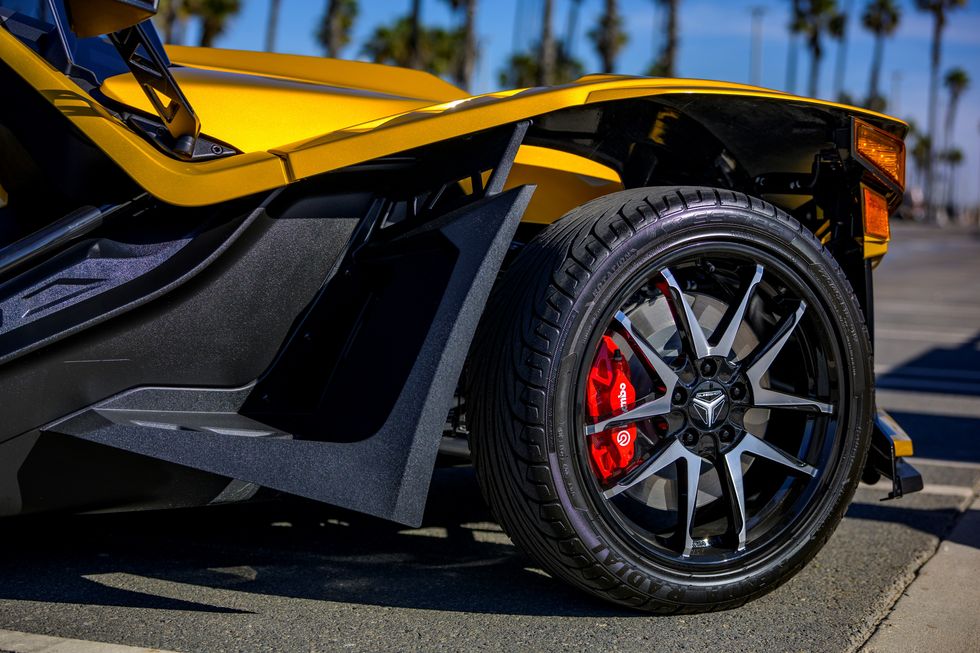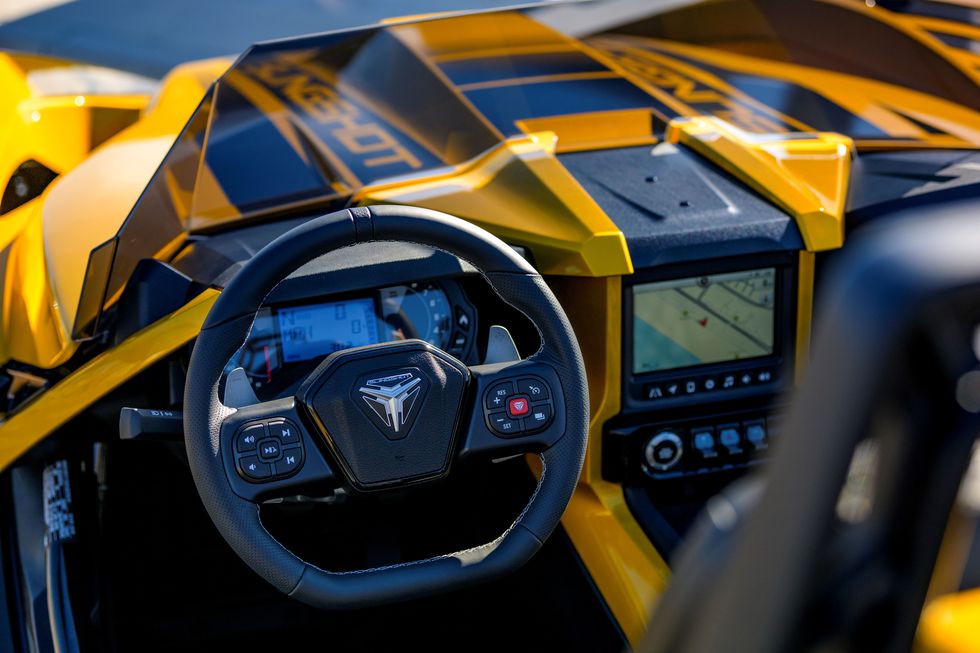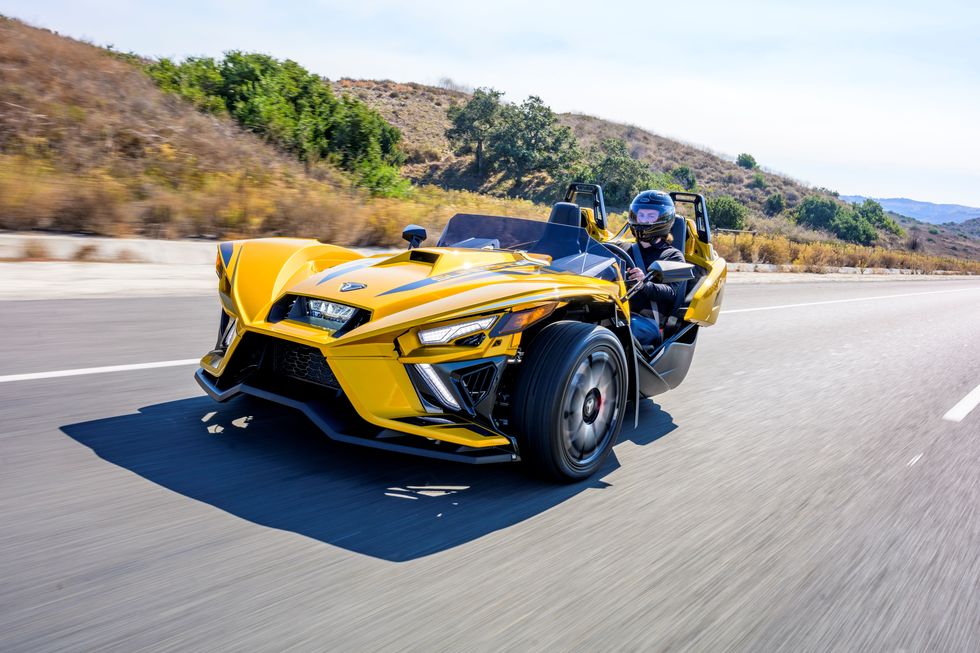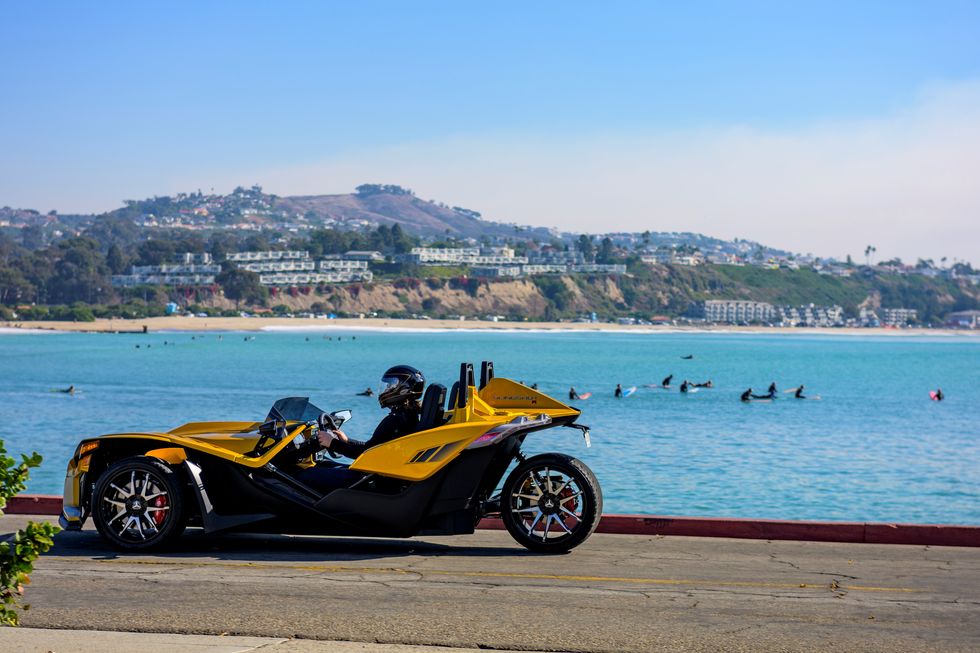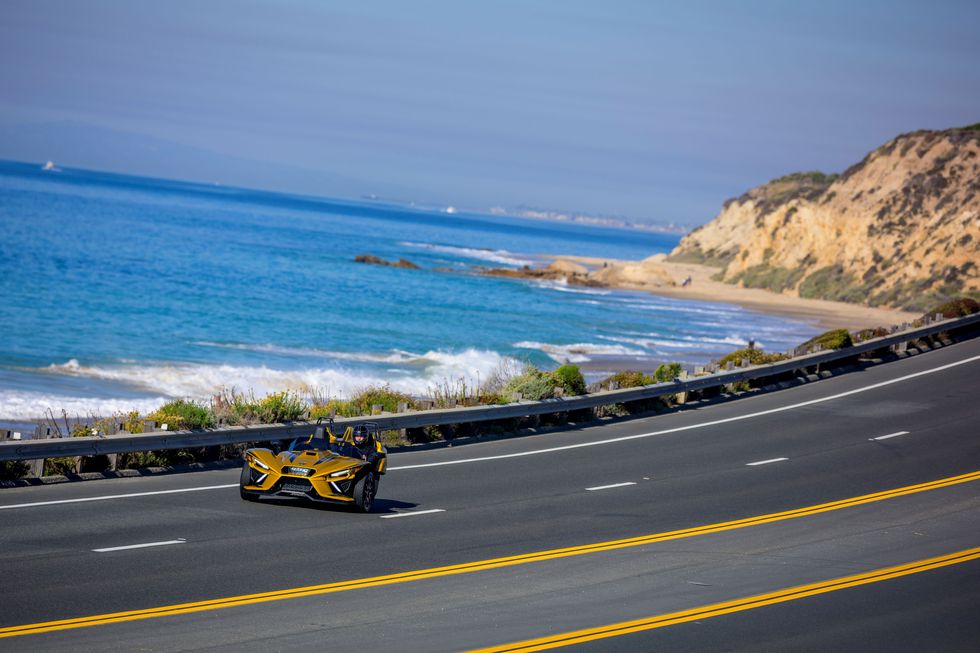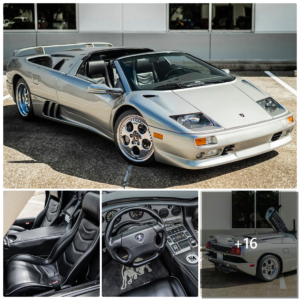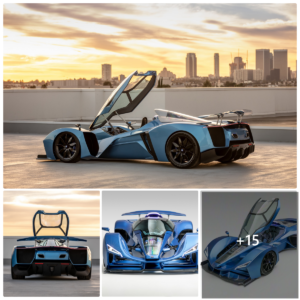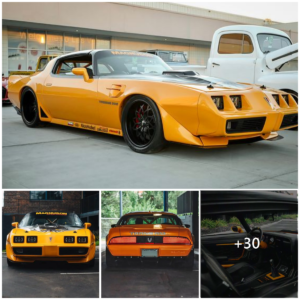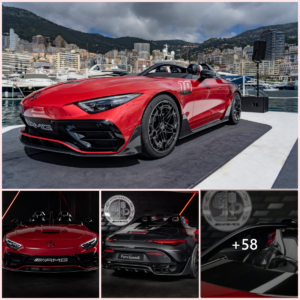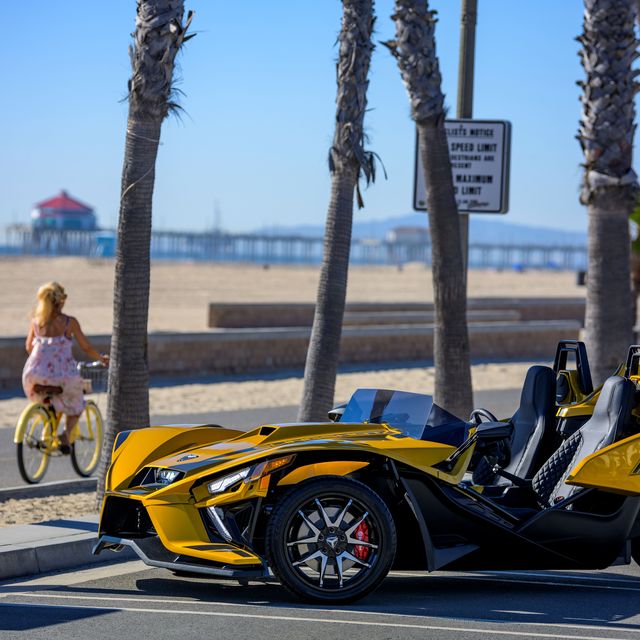
POLARIS
You do not drive your Polaris Slingshot, you go for a ride in it. That may seem confusing, since you control your ride with a steering wheel, sit in a chair, and accelerate with a pedal on the floor, but drives are for cars, and this is not a car. It is a “three-wheeled motorcycle,” as Polaris disclaims. The government legally classifies it as an autocycle, which accomplishes a few things, most notably legal exceptions from safety standards for low-production vehicles. It also provides a convenient excuse for buyers when their passengers ask why their new autocycle does not have doors, windows, or anything near an effective interpretation of the concept of a windscreen.
The 2024 model year is the tenth in the three-wheeled business for Polaris. The once-humble Slingshot has become a reliable product with its own community, one that has embraced the Slingshot for what it is rather than what it is not. That has allowed the brand to expand its lineup to four variants: S, SL, SLR, and R. The brand has also added some surprisingly useful comfort features to the higher-end Slingshots. The R variant even includes Apple CarPlay integration, one of a half-dozen giveaways that this particular autocycle might be something like a car after all. Heated and cooled seats are available as accessories, as is something resembling a roof.
Prices start at $21,999 for the basic, manual S model and go all the way up to $40,299 for a limited-edition Roush model with an AutoDrive transmission. The manual R, the one you want to experience the best strengths of the Slingshot with the most complete group of options, can be had for $34,799. That is a few thousand more than the Mazda MX-5 Club, the most affordable model with its all-important limited-slip differential. Since Slingshots have just one drive wheel, all models are equal in their complete lack of a differential.
Slingshot buyers have two transmission options, a five-speed manual an “AutoDrive” semi-manual gearbox that reminds you why automatic E60 M5s are so much more affordable than manual options. The manual is about as good as you could expect in this application, with a satisfying crunch through every gear and a clutch that that pairs well with the unique feeling of determining how much power is going to just one drive wheel.
The automatic is another story, indecisive and slow. For the first time in decades you may start to question the now-conventional wisdom that a modern automated gearbox is faster than a manual. One Polaris representative said that the Slingshot is faster with the automatic, but that feels like a misdirection. The vehicle is more about experience and less about performance. This automatic is certainly not a more satisfying experience. The AutoDrive transmission is good because it offers more people the opportunity to ride the Slingshot, but it has few other charms. If you can operate three pedals, make sure you choose the manual transmission.
That manual pairs well with the 2.0-liter engine, a new addition for the autocycle’s major 2020 refresh. The four-cylinder revs to 8500 RPM, produces 203 hp, and gives Slingshot owners all the power they want over a massive range. It may fall short of an S2000, but it is a satisfying engine that stands out and suggests that the front half of a Slingshot could make an excellent sports car if it were paired with a more traditional set of two rear tires in the back.
Unfortunately, as long as the Slingshot is designed around its core gimmick, it will always have an obvious weakness. If you choose the manual transmission, everything in front of the driver is somewhere between good and great. A lightweight, relatively affordable car with this particular combination of a double wishbone suspension, a high-revving engine, a satisfying transmission, and an open-air cockpit would make for a spectacular, albeit limited, sports car. This is not a sports car, though, because it is not a car. The compromises come at the back, where a single rear wheel mounted to a simple swingarm holds back everything.
Some of the drawbacks are predictable. One tire means the vehicle has half the rear grip you expect, something that is going to come up every single time you roll out from a stoplight and spin the lone tire. The lack of suspension lean also means that the rear tire is not going to act like the fronts in a corner, which means that the Slingshot is not only going to occasionally slide out from underneath you but may surprise you in the exact way it decides to slide. True to its nature as an autocycle, this makes for a vehicle with the front end of a sharp road car and a rear end that feels about as compliant as the casters on a shopping cart.
The third wheel brings some more unique issues, too. If you see an obstacle in the road, Polaris will remind you that the rear wheel will hit it if you split it as you would in a car. Evasive maneuvers instead have to fit into the narrow gaps between the wheels on either side. Traditional tread patterns would spray water toward the third wheel in wet conditions, so the Slingshot has unique tires that are designed to spray water away from the wheel. That means you cannot help the vehicle’s general lack of grip with a set of softer and more aggressive Summer rubber from Pirelli or Michelin.
These are major weaknesses, but the resulting vehicle is is still exactly as fun as anything called a “Slingshot” should be. Around a tight canyon, that wide front end turns in well and that high-revving engine screams along at any possible speed you would feel comfortable driving a three-wheeler that does not have any sort of metal frame around its windscreen. Corner exits are an adventure every time, and little slides are an inevitability even with the help of traction control. The combination of a smaller overall contact patch and limited rubber make both braking and acceleration more of an ordeal than you might hope, but spinning the rear tire just about every time you get on the throttle has its charms.
The fun parts are not the reason most people buy a three-wheeler. The real novelty of a Slingshot is being seen in one. At every stoplight along the excruciatingly slow drive up Orange County’s beach communities, our convoy of Slingshots drew phone cameras and shameless stares. In the face of the visual magnetism of the Slingshot, everything from a Lamborghini Urus to a camouflaged next-gen Porsche Panamera test car was overshadowed. If you want to attract attention in public, this is one of the most affordable ways to do just that. If you do not, you should look for something else. This is a vehicle for people who want to be seen inside of a Polaris Slingshot, not for people who want to go about their business without attracting attention.
This is a novelty, and a strong option as far as novelties go. If you want a sports car, look for a Mazda MX-5 or a Toyota GR86. But the Slingshot has carved out a niche for itself, one that sidesteps its disadvantages. If you want to burn through a single rear tire quickly with a smile on your face and a whole lot of strangers watching, there’s little on the market that does the job better.
